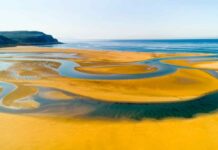Anyone driving in Iceland will quickly learn a thing or two about the country’s roads. To start, Iceland’s Ring Road (Route 1) circumnavigates the island. It’s a paved, two-lane highway that any vehicle can drive on. When you decide to go further inland and enter the Highlands, you’ll need to drive on Iceland’s F-roads. But what exactly is an F-road? Are they open all year long? And how do you drive on them when visiting Iceland’s Highlands? You may have heard that you need a special type of vehicle and that you may even need to ford rivers. Let’s learn more about driving on Iceland’s mountain roads.

What is an Iceland F-Road?
Simply put, an F-road in Iceland is a mountain road. The letter F stands for “fjall”, which means “mountain” in Icelandic. It’s easy to know when you are approaching an F-road because they are signaled with the letter F as a prefix. So F206 is mountain road 206. It’s important to know this distinction because only certain types of vehicles are allowed on Iceland’s F Rhodes. We’ll go more into that later. You’ll find the majority of Iceland F roads in the country’s Highlands. This interior part of the country is much more rugged and wild than the cities and villages that dot the Ring Road. You’ll find tons of glaciers, hot springs, hiking areas like Landmannalaugar, and lots of other zones worth exploring. One of the access roads to the spectacular Gullfoss waterfall is also an F-road.

How Do I Drive on Iceland’s F-Roads in the Highlands?
The first thing to know about Iceland F-roads is that they’re not usually not paved. Combine this with slightly changing and ever treacherous road conditions, and you can understand why you are not allowed to drive just any old vehicle on Iceland’s F-roads. Your car or campervan specifically needs to have a four-wheel drive. All-terrain vehicles are not just the smarter choice when driving in the mountains. They’re mandated by Icelandic law. You will want to have tires with good traction and have complete control over steering while maneuvering the unpaved or gravel roads you encounter. It’s imperative to have an experienced driver. Some people even hire guides or professionals for the more difficult tasks, like fording a river along an F-road.
A word to the wise: if you’ve never crossed a river in a vehicle, leave it to the professionals. You don’t want to flood your engine and ruin your rental. Your bank account may never forgive you. I also may never forgive you.
When Do Iceland’s Mountain Roads Open?
Another important piece of information for anyone planning a road trip in Iceland is that F-roads are not open all year long. Because of their high altitude and constantly changing weather conditions, it’s too dangerous to drive in the mountains most of the year.Between things freezing in the fall and thawing out in the spring, many sections of F-roads are closed due to being impassable. They’re also not serviced in the winter. While there’s no official opening date, many of Iceland’s mountain roads open in June. Some have opened as late as July. this is because the weather is unpredictable, and changes every year. Officials at the Icelandic Road and Coastal Administration need to make sure that the passes are 100% safe before giving the green light. Once the summer season is over, usually at the end of August, the roads close again. You can find more information and average opening times for the main F-roads in Iceland.

What is an Iceland F-Road and When Do They Open?
Iceland’s mountain roads provide another way to explore the island’s mountainous Highlands and dramatic volcanic interior during the summer months. As long you have the right 4×4 vehicle for your adventures, you’re all set! Check the weather forecast and stay up to date on road conditions with http://www.road.is/.


































